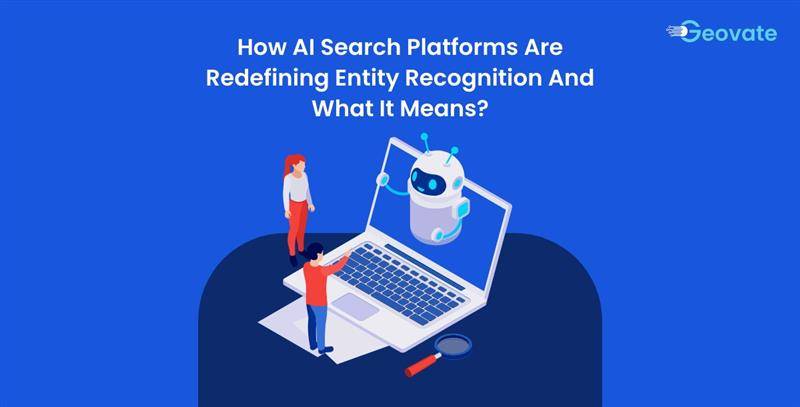How AI Search Platforms Are Redefining Entity Recognition And What It Means for the Future of Search?
Tue,11 Nov 2025 16:00:00- Font Size
- Share Content

Search as we know it has changed forever.
A few years ago, search engines focused almost entirely on keywords — matching what you typed with the same words found on web pages. But today’s AI-powered search platforms do something radically different. They look beyond words to understand meaning, relationships, and context.
At the core of this transformation is Entity Recognition — a technology that helps AI understand the world not as a list of words, but as a web of connected concepts.
In this guide, we’ll explore how AI search platforms use entity recognition, why it matters for businesses and content creators, and how it’s shaping the next era of digital discovery.
What Is Entity Recognition?
Entity Recognition — often called Named Entity Recognition (NER) — is a branch of Natural Language Processing (NLP) that enables machines to identify and classify the key “things” mentioned in text.
Those things could be:
- People (e.g., Sundar Pichai, Taylor Swift)
- Organizations (e.g., Google, NASA)
- Locations (e.g., London, Mount Everest)
- Products (e.g., Tesla Model 3, iPhone 15)
- Concepts (e.g., sustainability, artificial intelligence)
When an AI system reads a sentence like:
“AI-driven mapping tools are transforming logistics in New York,”
it doesn’t just see words. It identifies “AI-driven mapping tools” as a technology, “logistics” as an industry, and “New York” as a location.
This process helps search engines and AI assistants understand how all these entities connect — allowing them to retrieve and generate far more accurate, contextually relevant results.
From Keywords to Concepts: The Shift Toward Semantic Search
Traditional search relied on literal keyword matches. If you typed “best pizza in Delhi,” the engine looked for pages containing “best,” “pizza,” and “Delhi.”
That approach worked — but only to a point. It often ignored context, synonyms, and intent.
Modern AI-driven search systems go deeper. They use semantic understanding — powered by entities — to interpret what users actually mean.
For instance, if someone searches for:
“Where did the CEO of Tesla study?”
The AI recognizes:
- “CEO” as a role (entity type)
- “Tesla” as a company entity
- The intent: find a person’s educational background
That’s not keyword search — that’s entity-based reasoning.
This entity-centric approach allows AI search platforms to understand relationships and context, not just literal text matches. It’s why search results today feel more intelligent, conversational, and human-like.
How AI Search Platforms Use Entity Recognition
Entity recognition is the foundation upon which AI search engines operate. Without it, large language models (LLMs) would struggle to distinguish between similar terms or maintain factual accuracy.
Here’s how AI search platforms use entity recognition at different stages of understanding and retrieval:
1. Contextual Understanding
AI search engines identify entities within a query to determine its true intent.
Example:
If a user searches “Apple revenue 2024,” the system identifies “Apple” as a company, not a fruit — because the surrounding context (“revenue 2024”) points to financial data.
This context-aware recognition allows the system to deliver accurate, domain-specific results.
2. Entity Linking and Disambiguation
Entities are rarely isolated. They’re connected in vast networks of meaning.
Entity linking connects an identified entity to its canonical source or reference — like a database ID, Wikipedia entry, or knowledge graph node.
For example, if someone searches “Paris,” entity linking helps the AI decide whether the user meant Paris, France, Paris Hilton, or Paris, Texas — based on context.
This disambiguation ensures precision and relevance, even for ambiguous queries.
3. Building and Updating Knowledge Graphs
Entity recognition plays a key role in maintaining knowledge graphs — structured databases that store relationships between entities.
Every time new content is published, AI systems extract entities, verify their connections, and update the graph. This allows the search engine to continually evolve and provide richer, more complete answers over time.
4. Generating Factually Accurate Responses
Generative AI search tools like ChatGPT, Gemini, and Perplexity use entities to build trustworthy answers.
Instead of randomly stitching sentences together, they use entity-linked data points to form accurate and factual narratives.
For example, when asked “Who designed the Tesla Model S?”, an entity-aware system pulls data directly connected to the entities “Tesla,” “Model S,” and “designer,” ensuring a correct and coherent response.
Why Entity Recognition Matters for Businesses
Entity recognition isn’t just a technical concept. It has real-world implications for SEO, content marketing, and brand visibility.
Here’s why organizations should care about this shift toward entity-driven search:
1. Improved Online Visibility
Search engines now recognize entities instead of just websites.
That means your brand, product, or service needs to be consistently identified as a distinct entity across the web — using accurate schema markup, structured data, and factual content.
When done right, this improves:
- Knowledge panel visibility
- Brand mentions in generative search answers
- Authority and trust signals across search results
2. Smarter, Entity-First SEO
Keyword stuffing is no longer the key to SEO success.
Modern optimization focuses on entities, their relationships, and contextual signals.
Instead of targeting “AI mapping services,” an entity-first strategy would structure content around the recognized concept “AI mapping,” linking it to related entities like “machine learning,” “geospatial analytics,” and “urban planning.”
This builds a strong semantic web around your brand — helping search engines understand expertise and relevance.
3. Content That Matches Real Intent
Entity-driven content creation ensures your pages match how users actually think and search.
Each blog, guide, or landing page should align with specific, meaningful entities in your domain.
For example, a company in the AI sector might create content around entities like:
- “Generative search models”
- “Knowledge graphs”
- “Natural language understanding”
- “Entity-based indexing”
By doing so, you’re not just writing for humans — you’re training AI to associate your content with key industry concepts.
4. Better User Experience
Entity-aware search delivers fewer irrelevant results.
When users find precisely what they’re looking for, faster, engagement and trust increase.
That’s why aligning your content structure with entity recognition principles improves both user satisfaction and conversion potential.
How Entity Recognition Shapes Real-World AI Applications
Entity recognition isn’t limited to search. It’s driving innovation across multiple industries.
Here are a few examples of how it’s being applied:
- Healthcare: AI systems identify medical entities such as diseases, symptoms, and treatments to improve diagnosis and drug discovery.
- Finance: Algorithms detect company names, currencies, and market events from news data for real-time trading insights.
- Transportation: Geospatial AI uses entity detection to map locations, traffic patterns, and infrastructure in smart city planning.
- E-commerce: Platforms recognize product entities and user preferences to recommend personalized options.
In each case, entity recognition provides structure, clarity, and meaning — enabling AI systems to “understand” complex data in human-like ways.
The Future of Search: From Answers to Understanding
As AI continues to evolve, the very idea of “search” is being reimagined.
We’re moving from traditional engines that find information to intelligent systems that comprehend and synthesize it.
Here’s what the next era of entity-driven search will bring:
1. Hyper-Personalized Results
Entity-based personalization means search platforms will tailor results based on individual users’ unique entity profiles — including interests, locations, and interaction history.
You won’t just get search results; you’ll get insights built around your context.
2. Real-Time Knowledge Graphs
Knowledge graphs will soon update dynamically — integrating new data instantly as entities evolve.
Imagine searching for a breaking news topic and seeing verified, connected insights appear in real time — all powered by live entity linking.
3. Multi-Modal Entity Recognition
Future AI systems will combine text, images, voice, and video recognition to understand entities across all content types.
That means an AI could identify the same object in a written article, spoken transcript, and image caption — and connect them seamlessly.
4. AI Assistants That Truly Understand Context
Next-generation AI search tools will act as knowledge companions — capable of remembering entities you’ve mentioned in past queries and building on them in future interactions.
This evolution will make search not just smarter, but more conversational and intuitive.
How to Prepare for the Entity-Driven Future
Businesses and marketers can stay ahead by rethinking their content and data strategies through an entity-first lens.
Here’s how:
- Implement Schema Markup
Use structured data to clearly define the entities mentioned on your website — such as products, services, locations, or people. - Maintain Consistency
Use the same entity names and attributes across all online platforms, from your website to social media profiles. - Create Entity Hubs
Build dedicated “hub” pages that comprehensively cover specific topics or concepts. Link related subpages back to these hubs using consistent anchor text. - Optimize for Semantic Relevance
Write naturally but ensure each paragraph reinforces a meaningful relationship between entities. - Monitor Entity Performance
Use SEO tools and AI analytics to track how often your key entities appear in search results or AI-generated summaries.
Final Thoughts
The shift from keyword-based search to entity-driven understanding marks one of the most transformative changes in digital technology. With entity recognition, AI no longer just matches words — it understands context, intent, and relationships between concepts. This evolution allows search platforms to move beyond retrieving information to actually interpreting meaning, creating smarter, more human-like search experiences.
For businesses and content creators, embracing an entity-first approach is now essential. Success in an AI-driven world depends on creating structured, context-rich content that defines clear relationships between entities. This not only enhances visibility and credibility but also ensures long-term relevance as search evolves from finding answers to truly understanding meaning.
